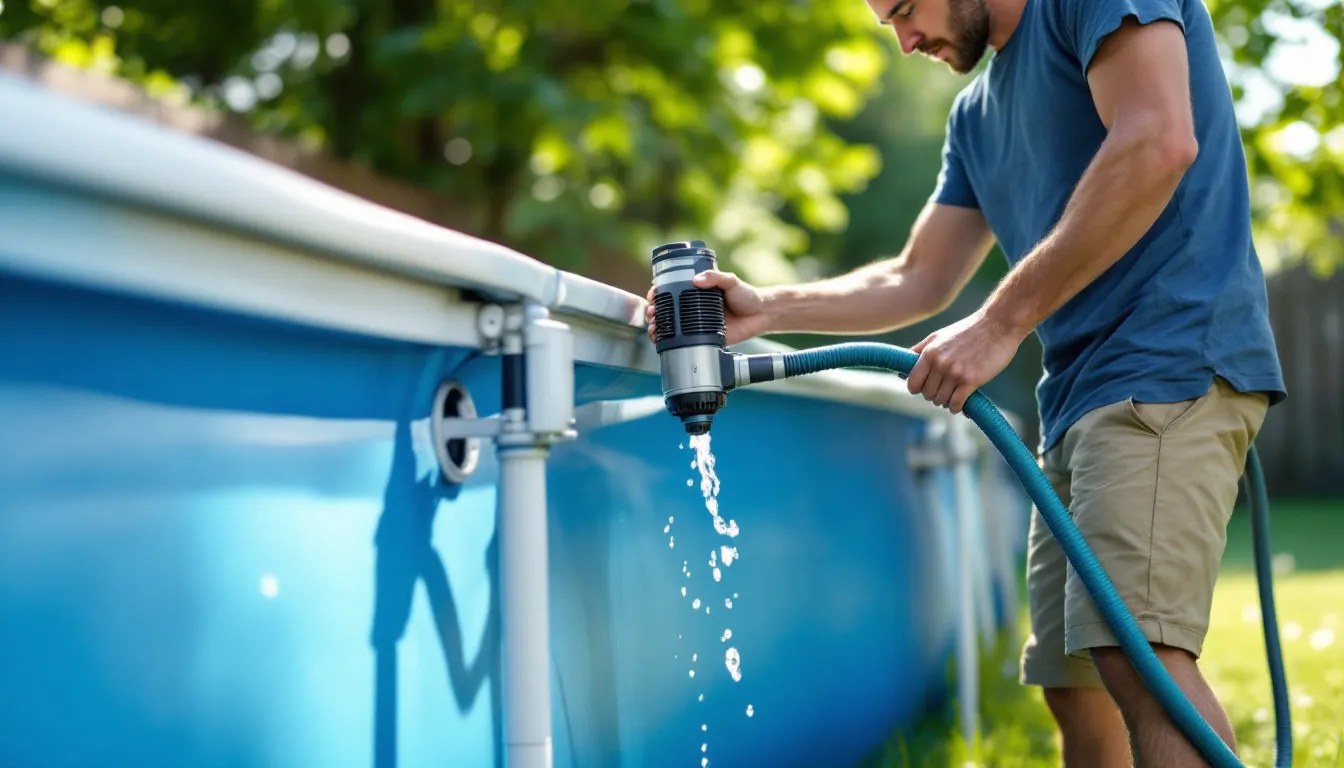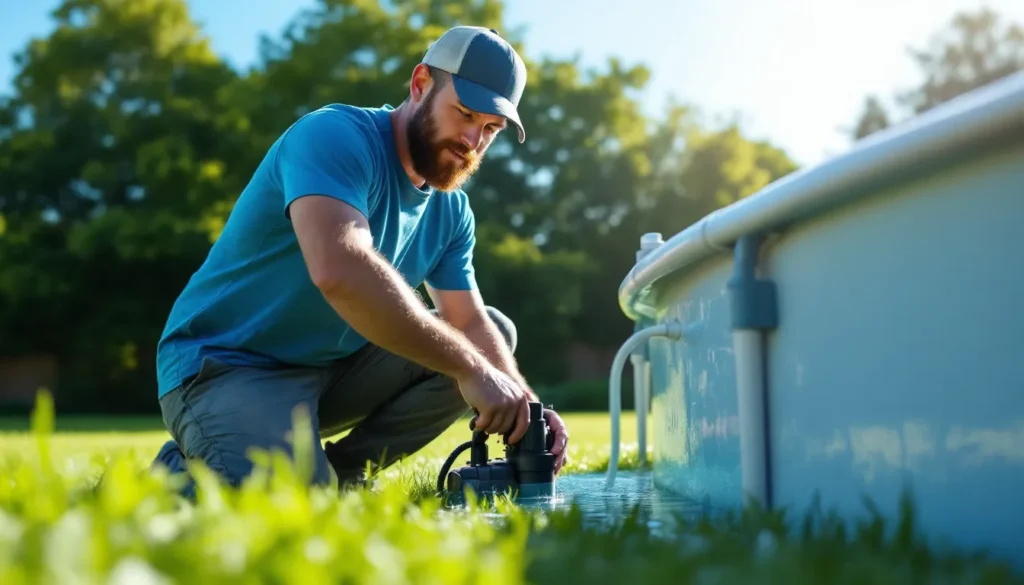Key Takeaways
- Importance of Draining: Properly pumping water out of your pool prevents structural damage from freezing, reduces algae growth, and simplifies maintenance and repairs.
- Necessary Equipment: Use the right tools like submersible pumps, utility pumps, and portable electric pumps, along with essential supplies such as garden hoses, extension cords, and skimmer baskets.
- Step-by-Step Process: Follow a clear procedure when pumping water, including preparing the pool area, setting up the pump, operating the pump, and monitoring the water level.
- Safety First: Prioritize safety by ensuring all electrical equipment is waterproof, keeping connections above water, and adhering to chemical disposal regulations to protect both the environment and health.
- Regular Maintenance: Schedule seasonal maintenance by effectively pumping water to prepare your pool for winter, promoting a healthier and cleaner swimming experience for the following season.
When summer’s over and it’s time to close up your pool, figuring out how to pump water out can feel daunting. But don’t worry; you’re not alone in this task. Properly draining your pool is essential for maintenance and prevents damage during the colder months.
Understanding The Need To Pump Water Out Of A Pool
Pumping water out of a pool is essential for multiple reasons. First, maintaining the pool’s structure prevents issues like cracks and damage caused by freezing water. Second, ensuring water levels drop helps ease repairs, cleaning, and maintenance.
Clearing out excess water reduces the risk of algae and bacteria growth, promoting a healthier swimming environment for next season. Additionally, proper draining aids in equipment servicing, allowing you to check for damage and perform necessary repairs without hassle.
Pumping water before winter creates space for rain and snow, reducing overflow risks. Furthermore, it keeps your pool cover secure and prevents debris buildup during colder months. Understanding these needs encourages timely action, ensuring a well-maintained and ready-to-use pool.
Equipment Needed For Pumping Water

To pump water out of your pool efficiently, specific equipment and tools are essential. Understanding each type and its function can streamline the process.
Types Of Pumps
- Submersible Pump
Submersible pumps operate underwater. They’re effective for deep pools and can remove large volumes of water quickly.
- Utility Pump
Utility pumps are versatile, suitable for shallow water removal. They connect to a standard garden hose and often handle light debris.
- Sump Pump
Sump pumps work well for areas that accumulate groundwater. They can handle both water and sediment, making them useful when combined with pool drainage.
- Portable Electric Pump
Portable electric pumps provide mobility. They’re suitable for smaller pools and are usually lightweight for easy transport.
Additional Tools And Supplies
- Garden Hose
Connect a garden hose to the pump for effective water discharge. Ensure the hose is long enough to reach a proper drainage area.
- Extension Cord
Use an extension cord if the pump’s power source is far away. Ensure the cord is rated for outdoor use to prevent electrical hazards.
- Filter Socks
Place filter socks over pump intakes to capture debris. This prevents clogging and prolongs the pump’s lifespan.
- Skimmer Basket
A skimmer basket traps larger particles and debris. Use it in conjunction with the pump to keep your setup efficient.
- Clamps and Connectors
Utilize clamps and connectors for secure fittings. They prevent leaks and ensure a smooth flow of water out of the pool.
Having the right equipment simplifies the water pumping process and maintains a well-kept pool.
Step-by-Step Guide On How To Pump Water Out Of Pool
Pumping water from your pool involves clear steps that ensure efficiency and safety. Follow this guide to effectively manage the water evacuation process.
Preparing The Pool Area
- Clear the vicinity: Remove all furniture, toys, and any debris from the pool area. Ensuring an unobstructed space allows for smooth operation.
- Inspect the pool surface: Check for sharp objects or broken tiles that could damage equipment. Fix any visible damage before proceeding.
- Clean skimmer baskets: Empty skimmer baskets to prevent blockage. Clear water flow supports efficient pumping.
- Gather equipment: Collect necessary pumps, hoses, and tools as listed previously. Having everything handy minimizes downtime.
Setting Up The Pump
- Select the right pump: Choose a submersible or utility pump based on the pool’s conditions. Ensure compatibility with your pool size.
- Position the pump: Place the pump in the deepest area of the pool, ensuring it remains submerged. This placement maximizes water removal.
- Connect hoses: Attach the discharge hose securely to the pump’s outlet. Ensure the other end directs water away from the pool and any nearby structures.
- Secure the connection: Use clamps or tape to fasten connections. This prevents leaks during pumping.
Operating The Pump
- Plug in the pump: Connect the pump to a power source, using an extension cord if necessary. Check for wet surfaces to avoid electrical hazards.
- Turn on the pump: Activate the pump and observe its operation. Monitor for unusual noises or vibrations that indicate a problem.
- Check the water level: Regularly monitor the water level. Shut off the pump when water reaches the minimum operational level to avoid damage.
- Maintain oversight: Stay nearby while pumping. Ensure the hose remains clear and unclogged to facilitate effective water flow.
Following these steps allows you to pump out water from your pool effectively, enabling maintenance and preparation for the upcoming season.
Safety Considerations
Safety is crucial when pumping water out of your pool. Follow these guidelines to ensure a safe and efficient process.
Electrical Safety
Ensure all electrical equipment, including pumps and extension cords, is waterproof and rated for outdoor use. Keep electrical connections above the waterline to prevent accidents. Check that all equipment is in good working condition before use. Use a ground fault circuit interrupter (GFCI) outlet to reduce the risk of electrical shock. Avoid handling electrical devices with wet hands or while standing in water.
Chemical Considerations
Consider the chemical levels in your pool water before draining. High chlorine levels can pose health risks if released into the environment. Test the water and wait at least 24 hours after shocking the pool before draining. Consult local regulations regarding chemical disposal to ensure compliance. Store chemicals and equipment properly to prevent accidental contamination. Always wear protective gloves and eyewear when handling pool chemicals.
Conclusion
Pumping water out of your pool is a crucial step in maintaining its integrity and preparing for the colder months. By taking the time to properly drain your pool you’re not only protecting it from potential damage but also creating a healthier environment for future use.
With the right equipment and a clear plan you can tackle this task efficiently. Remember to prioritize safety throughout the process and adhere to local regulations regarding chemical disposal.
By following the steps outlined in this guide you’ll ensure your pool remains in top shape and ready for enjoyment when the warm weather returns. Take action now to safeguard your investment and enjoy a worry-free pool experience in the future.

Hi, I’m Md Rofiqul, a gardening enthusiast who loves spending time in the garden and backyard. I enjoy caring for plants, growing flowers and vegetables, and creating a green space that feels peaceful and refreshing. Gardening is more than just a hobby, it’s a passion that connects me to nature and brings joy to my daily life. Living with plants inspires me to embrace simplicity, patience, and sustainability while making every day more colorful and rewarding.
